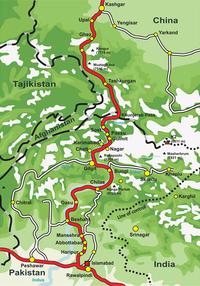
Photo from wikipedia
Identification of failure susceptible slopes through different rock engineering approach is highly valuable in landslide risk management along crucial highway corridors in the high mountainous region. In this study, a… Click to show full abstract
Identification of failure susceptible slopes through different rock engineering approach is highly valuable in landslide risk management along crucial highway corridors in the high mountainous region. In this study, a critical highway (NH-5) segment in higher Himalaya has been investigated using the various rock mass characterization schemes based on detailed field observations. Since the highway corridor is highly susceptible to discontinuities-driven failures, consisting of jointed rock masses; Mean and Combined kinematic feasibility analysis has been performed for 20 highway slopes. Observed slope mass classes have been compared to the feasibility percentage of discontinuities driven failures (wedge, toppling, and planar) and accordingly the kinematic feasibility zonation along highway segment has been done for each as well as overall failure types. Based on the slope mass conditions and discontinuities driven failures probability (%), responsive remedial measures have been proposed for individual highway slopes to ensure safe and uninterrupted transportation.
Journal Title: Journal of Mountain Science
Year Published: 2020
Link to full text (if available)
Share on Social Media: Sign Up to like & get
recommendations!